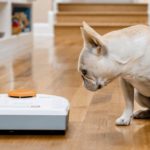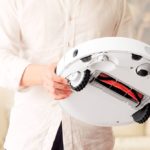What is a robot vacuum cleaner
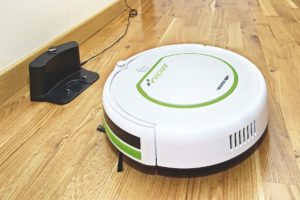 The device is positioned as an autonomous vacuum cleaner equipped with intelligent software and a vacuum cleaning system for cleaning houses. Such devices can operate without human assistance. It is also possible for a person to deliberately control the vacuum cleaner using an APP, Wi-Fi or Bluetooth remote control while away from home. Robotic vacuum cleaners work similarly to regular vacuum cleaners, but without human intervention. Most devices operate on the principle of cleaning in one direction as much as possible. When they hit an obstacle, they turn and continue their work. Vacuum cleaners are programmed to independently collect all particles of dust and debris.
The device is positioned as an autonomous vacuum cleaner equipped with intelligent software and a vacuum cleaning system for cleaning houses. Such devices can operate without human assistance. It is also possible for a person to deliberately control the vacuum cleaner using an APP, Wi-Fi or Bluetooth remote control while away from home. Robotic vacuum cleaners work similarly to regular vacuum cleaners, but without human intervention. Most devices operate on the principle of cleaning in one direction as much as possible. When they hit an obstacle, they turn and continue their work. Vacuum cleaners are programmed to independently collect all particles of dust and debris.
Today, there are many brands available that are designed to update your living space on a daily or weekly basis. Most models are well suited for cleaning hard floors.
The content of the article
Device Features
The vacuum cleaner has a motor, just like a regular vacuum cleaner. Almost all robotic cleaners use two drive wheels.
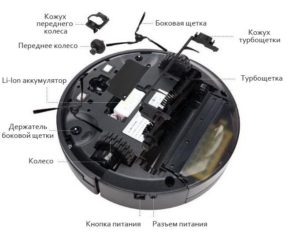 The devices have a variety of sensors inside the car and underneath the device, which provides feedback from the environment and detects obstacles in its path, such as stairs or furniture. The sensors also convey the distance traveled and the state of the electronics.
The devices have a variety of sensors inside the car and underneath the device, which provides feedback from the environment and detects obstacles in its path, such as stairs or furniture. The sensors also convey the distance traveled and the state of the electronics.
There are three stages of operation for most automatic vacuum cleaners and four stages for some models:
- Dual wide side brushes rotate together to catch and transfer dirt, dust, hair and debris from corners and edges to the center of the main brush.
- The main roller brush captures hair and debris with its bristles, removing dirt, dust, and stains.
- The powerful motor sucks dirt into the filtered waste basket through the air intake. While the filter removes tiny particles of dust, mites and allergens from the air.
- The water reservoir continuously dispenses liquid onto the microfiber cloth, and the device uses the damp cloth to scrub your floor in a back-and-forth motion, easily removing stubborn dirt from your floors.
Attention! Robot vacuum cleaners are not capable of going up or down stairs. The power of an automatic vacuum cleaner cannot match the suction power and performance of an upright vacuum cleaner, so this technique cannot provide regular deep cleaning.
Characteristics of the vacuum cleaner
The robot must have excellent performance and battery life. Devices can be upgraded with new software for more efficient cleaning. Parts and accessories are easy to replace, as are batteries.
The program moves the vacuum cleaner to a new work area, so there is no need to monitor cleanliness. Guided by an intelligent navigation algorithm, the robot navigates and navigates easily around obstacles, changing its route to clean rooms more thoroughly.
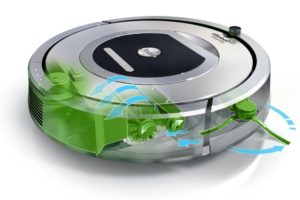 Wi-Fi enabled vacuum robot can bring more convenience.By installing a specific application on a mobile device, it is possible to easily use our smartphone or tablet as a remote control to control the robot. The cleaning program can be built into the robot's memory using a simple sequence of buttons; this tells the robot to leave the station on the designated day and time to clean the house. It returns only when the cleaning task is completed or the battery runs out while the task is running. If the battery runs out before completing the cleaning task, the robot will abort its task and return to the docking station.
Wi-Fi enabled vacuum robot can bring more convenience.By installing a specific application on a mobile device, it is possible to easily use our smartphone or tablet as a remote control to control the robot. The cleaning program can be built into the robot's memory using a simple sequence of buttons; this tells the robot to leave the station on the designated day and time to clean the house. It returns only when the cleaning task is completed or the battery runs out while the task is running. If the battery runs out before completing the cleaning task, the robot will abort its task and return to the docking station.
Most robot vacuum cleaners usually use multiple smart sensors, such as edge sensor, cliff sensor, collision sensor, obstacle sensors, ultrasonic radar sensor, laser distance sensor, gyroscope sensor. This way, the robots can move freely around the house and automatically adapt to their surroundings to thoroughly clean the floor.
The robot can charge itself automatically. First select a robot access location for the docking station, and the robot will return automatically before it fails.
Also some robot cleaners that use an additional technology called "virtual wall" which is an infrared beam of light that is sent from the device to act as a virtual wall, when the robot senses the light signal it changes direction to avoid that specific area.
Types of robot vacuum cleaners
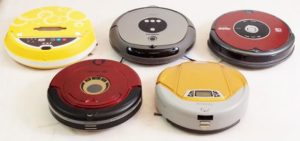 The following types of automatic vacuum cleaners can be distinguished:
The following types of automatic vacuum cleaners can be distinguished:
- for dry cleaning;
- for wet cleaning;
- equipment with both functions.
For dry cleaning
Such a device works on the principle of a simple vacuum cleaner, capturing foreign elements with brushes and sucking them into a designated container. In this case, some of the dust is deposited on the filter.
Good examples of such devices are: Foxcleaner, Iboto, Arnagar and other budget models.
For wet processing
The second type of vacuum cleaner supports the function of washing the floor. The device sprays liquid throughout the space and then wipes the water away with a cloth. Used water is placed in a container. Drying can be accomplished in a variety of ways, including air flow or wiping with silicone rubber.
Attention! This technique is not suitable for treating carpets, parquet or laminate floors that are vulnerable to water.
Combined model
To process a large area, it is good to use a 2 in 1 model to combine all functions in one device. Thus, the robot will both sweep and wash the floor surface. Similar devices are produced under the brands FOX cleaner, Super ProJet, Ziclean tornado.

